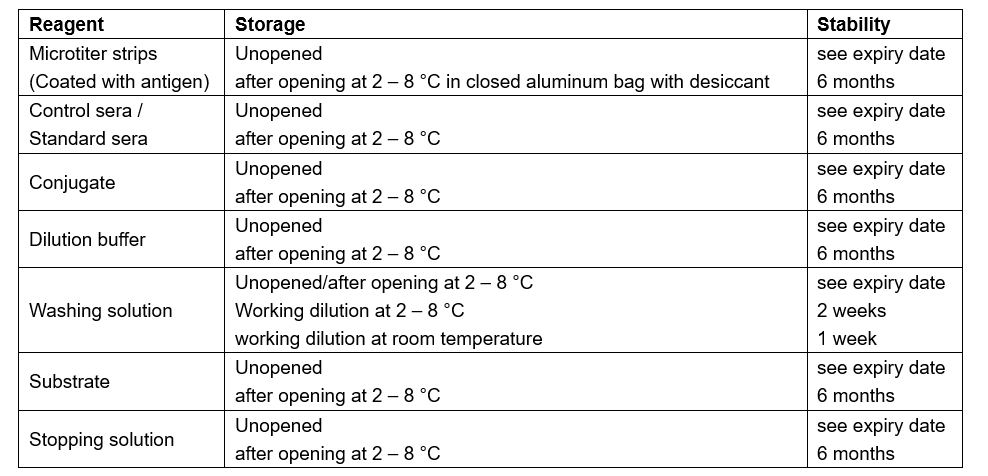Human Brucella IgA ELISA Kit
Regulatory status: For research use only, not for use in diagnostic procedures.
Sample
serum, plasma
Species Reactivity
Human
Intended Use
Quantitative and qualitative tests for detection of human antibodies in serum and plasma directed against Brucella species.
Contents of Kit
1.Break apart microtiter test strips each with 8 antigen coated single wells (altogether 96) MTP, 1 frame, the coating material is inactivated, 12
2.Standard serum (ready-to-use) STD Human serum in phosphate buffer with protein; negative for anti-HIV-Ab, HBs-Ag (Hepatitis B-Virus-surface antigen) and anti-HCV-Ab; preservative: < 0.1 % sodium azide, colouring: Amaranth O, 2 x 2 ml
3.Negative control serum (ready-to-use) NEG Human serum in phosphate buffer with protein; negative for anti-HIV-Ab, HBs-Ag (Hepatitis B-Virus-surface antigen) and anti-HCV; preservative: < 0.1 % sodium azide, colouring: Lissamin green V, 2 ml
4.Anti-human-IgA-conjugate (ready-to-use) APC Anti-human-IgA from goat (polyclonal), conjugated to alkaline phosphatase, stabilized with protein stabilization solution, preservative: 0.01 % methylisothiazolone, 0.01 % bromnitrodioxane, 13 ml
5.Washing solution concentrate (sufficient for 1 litre) WASH Sodium chloride solution with Tween 20, 30 mM Tris, preservative: < 0.1 % sodium azide, 33.3 ml
6.Dilution buffer DILB Phosphate buffer with protein and Tween 20; preservative: < 0.1 % sodium azide 0.01 g/l Bromphenol blue sodium salt, 2 x 50 ml
7.Stopping solution STOP 1.2 N sodium hydroxide, 15 ml
8.Substrate (ready-to-use) pNPP Para-nitrophenylphosphate, solvent free buffer, preservative: < 0.1 % sodium azide, (Substrate in unopened bottle may have a slightly yellow coloring. This does not reduce the quality of the product!), 13 ml
9.Quality control certificate with standard curve and evaluation table INFO (quantification of antibodies in IU/ml or U/ml), 1
2.Standard serum (ready-to-use) STD Human serum in phosphate buffer with protein; negative for anti-HIV-Ab, HBs-Ag (Hepatitis B-Virus-surface antigen) and anti-HCV-Ab; preservative: < 0.1 % sodium azide, colouring: Amaranth O, 2 x 2 ml
3.Negative control serum (ready-to-use) NEG Human serum in phosphate buffer with protein; negative for anti-HIV-Ab, HBs-Ag (Hepatitis B-Virus-surface antigen) and anti-HCV; preservative: < 0.1 % sodium azide, colouring: Lissamin green V, 2 ml
4.Anti-human-IgA-conjugate (ready-to-use) APC Anti-human-IgA from goat (polyclonal), conjugated to alkaline phosphatase, stabilized with protein stabilization solution, preservative: 0.01 % methylisothiazolone, 0.01 % bromnitrodioxane, 13 ml
5.Washing solution concentrate (sufficient for 1 litre) WASH Sodium chloride solution with Tween 20, 30 mM Tris, preservative: < 0.1 % sodium azide, 33.3 ml
6.Dilution buffer DILB Phosphate buffer with protein and Tween 20; preservative: < 0.1 % sodium azide 0.01 g/l Bromphenol blue sodium salt, 2 x 50 ml
7.Stopping solution STOP 1.2 N sodium hydroxide, 15 ml
8.Substrate (ready-to-use) pNPP Para-nitrophenylphosphate, solvent free buffer, preservative: < 0.1 % sodium azide, (Substrate in unopened bottle may have a slightly yellow coloring. This does not reduce the quality of the product!), 13 ml
9.Quality control certificate with standard curve and evaluation table INFO (quantification of antibodies in IU/ml or U/ml), 1
Storage

General Description
Brucella ssp. are gram-negative amotile bacteria which live as intracellular parasites in a wide spectrum of farm animals. Human infection is mainly caused by Brucella melitensis ("Malta fever"), Brucella abortus ("Morburs Bang"), Brucella suis and Brucella canis. This bacteria, which can be transmitted by infected animals (zoonosis), their excrements and contaminated food, most often causes moderate or high fever. Undulating fever with afebrile intervals are characteristic for Brucella melitensis and Brucella suis infections.
Accurate diagnosis of Brucellosis most often relies on direct detection of the pathogen or detection of specific antibody response in serum or CSF. Direct pathogen detection in culture systems can be performed with samples of blood, bone marrow, synovial fluid or urine. More rapid results can be obtained with serological methods: agglutination, coombstest, Complement Fixation Test (CFT).
Accurate diagnosis of Brucellosis most often relies on direct detection of the pathogen or detection of specific antibody response in serum or CSF. Direct pathogen detection in culture systems can be performed with samples of blood, bone marrow, synovial fluid or urine. More rapid results can be obtained with serological methods: agglutination, coombstest, Complement Fixation Test (CFT).
Citations
Have you cited DEIA321 in a publication? Let us know and earn a reward for your research.
| Product Name | Cat. No. | Applications | Host Species | Datasheet | Price | Add to Basket |
|---|
| Product Name | Cat. No. | Applications | Host Species | Datasheet | Price | Add to Basket |
|---|
Online Inquiry
Catalog # DEIA321
Related Products
By targets
Related Resources
Ordering Information
Payment methods we support:
Invoice / Purchase Order
Credit card
Invoice / Purchase Order
Credit card
![]()